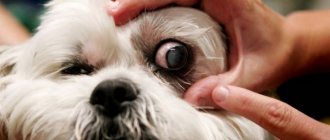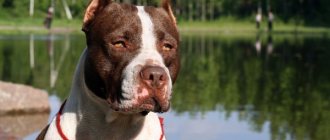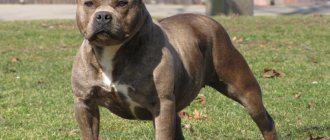Dog massage is a fairly common way to get an animal in order after an injury or simply keep it in good physical shape. The answer to the question of why dogs need massage is quite simple. It is used to get rid of various diseases, rehabilitation after fractures or for prevention. You can do it from a specialist or learn the technique yourself, and please your pet regularly and for free.
Dog massage
Benefit
For the first time in their lives, dogs are introduced to massage in infancy. When a mother licks her newborn puppies, she helps them breathe. When the cubs grow up, the mother kneads their tummies. This manipulation prevents constipation.
Massage for dogs is also necessary in adulthood. This is a good means of treating and preventing diseases. The benefits of massage treatments are as follows:
- Massaging movements stimulate blood circulation. As a result, blood flows to a certain area of the body, tissue nutrition and local metabolism improves. This promotes faster healing of injuries, which is why massage is often prescribed for injuries.
- The procedure stimulates the motor nerves. Therefore, massage is necessary for paralysis and weakness of the paw muscles. This rehabilitation activity helps restore movement.
- Massage helps to relax and calm the nervous system. This procedure is useful for a dog after experiencing stress, difficult training or an exhibition.
- Massage procedures improve peristalsis and facilitate easy bowel movements.
In many cases, dog massage can be done on your own. However, if your pet is seriously ill, the procedure should be performed by a professional. Not all types of massage treatments can be done at home.
Why do you need to massage
Massage is a universal procedure with a large number of positive effects, which allows you to restore tissue function without drug intervention. It can be prescribed to a dog as a therapeutic procedure for paralysis of the hind legs and simply weakness of the limbs due to a number of factors (arthrosis, arthritis, sprains, tendon ruptures, back injuries, degenerative diseases of the spine, etc.).
With the help of massage you can achieve the following positive effects:
- Improve blood circulation to the affected area, which will stimulate metabolic processes, oxygen saturation of tissues and, accordingly, speed up recovery processes.
- Increase muscle tone and activate tendon reflexes. Using mechanical action on areas that remain (completely or partially) without nervous regulation, it will be possible to activate the work of muscle fibers, stop or slow down their atrophy.
- Provide analgesic effect. Due to the impact of the hands on the subcutaneous fat tissue, biologically active substances (histamine, etc.) are released, which have an analgesic and vasodilator effect to temporarily alleviate the dog’s condition.
- Increase the conductivity of peripheral nerve trunks, which helps restore the functioning of nerve tissues and successful rehabilitation. A competent approach and timely procedures in some cases make it possible to return the pet to its former motor activity.
- Provide a general calming and relaxing effect.
Like other medical procedures, there are a number of contraindications for hind paw massage. These include open injuries, purulent infections, inflammatory processes, any neoplasms, high body temperature, bleeding, shock and epilepsy.
Indications
For what diseases is massage for dogs indicated? This procedure is effective for the following pathologies:
- diseases of the musculoskeletal system;
- injuries;
- constipation;
- inflammation and degeneration of joints;
- pain syndrome of various origins;
- neurotic disorders.
Healthy dogs should also get massages regularly. This will help your pet maintain a healthy musculoskeletal system into old age, as well as relieve stress and relax.
Contraindications
There are times when massage is contraindicated. This procedure should not be done under the following conditions:
- fever;
- any injuries and lesions of the skin (eczema, tumors, wounds, pustules);
- bleeding;
- fresh bone injuries with severe pain;
- epilepsy;
- severe liver and kidney diseases;
- shocked.
If your dog has at least one of the listed contraindications, then refuse massage. Otherwise, the treatment procedure will do more harm than good.
Rules for performing procedures
To help your pet and not harm his health, you should follow some rules. The atmosphere when working with a dog should be quiet, there should be no extraneous sounds.
You can use calm music. If an animal wants to look around, then it is worth giving him this opportunity.
You should massage your pet at least two hours after feeding. It is advisable to wash the dog or at least clean the skin of twigs and dirt. During the procedures, you can talk to the animal.
Sources
- https://zoostatus.ru/our-prices/about-prices/massaz-zivotnim/
- https://usatiki.ru/massazh-zadnih-lap-sobake/
- https://FB.ru/article/476032/massaj-dlya-sobak-tehnika-vyipolneniya-pri-kakih-zabolevaniyah-primenyaetsya
- https://hochumassazh.ru/kak-delat-massazh-dlya-sobak.html
- https://mirsobaki.ru/kak-sdelat-massazh-sobake/
[collapse]
Some tips
Before giving your dog a massage, check out the following advice from veterinarians:
- You will need a basic knowledge of canine anatomy and physiology. You can learn about the characteristics of the animal’s body from a veterinarian. You can also find this information yourself on dog breeding websites.
- During the procedure, turn your pet over to massage first one side and then the other. Try not to press on the stomach; this part of the body can only be lightly stroked. Otherwise, the abdominal organs may be damaged.
- If your pet is diagnosed with a serious illness, then it is better to entrust massage treatments to a specialist.
- If you give a preventative massage to a healthy dog, then the procedures should be regular. Try to spend at least 10 minutes on this every day. This will be a good prevention of the development of arthritis.
- If your pet is healthy, then pay attention to its reaction to the procedures. If the dog shows dissatisfaction (growls, flinches), then do not force it. You need to gradually accustom your animal to massage.
We do a general massage
Veterinarians recommend general massage to prevent disease. The methodology for carrying it out is as follows:
- Cover a hard surface with a soft cloth. Place your pet on it and stroke it from head to back.
- Massage the back first with your fingers and then with your palms. Gently knead the skin, trying not to put pressure on the spinal column.
- Focus on the sacrum. Massaging this area prevents joint diseases.
- Rub your paws from top to bottom. Then bend and straighten each finger.
- Gently pat your pet's belly. At the same time, avoid sharp pressure.
- Now move on to massaging the muzzle. Take the cheeks with your fingers. Lift them up and then lower them down. Stroke the chin, as well as the area around the nose and eyes.
Complete the procedure by stroking the tail from base to tip.
Relieving pain
How to massage a dog if something hurts your pet? The procedure technique is as follows:
- Place the dog on a blanket or the floor, make petting movements and talk to the dog in a soft voice.
- Rub your shoulders, neck and back in circular motions, as if you were kneading dough. Do not put too much pressure on your body, as this may increase the pain.
- Gently stretch your paw muscles. Move from their base down. Don't forget to massage your fingers.
- Direct impact on the source of pain is prohibited. You can only stroke and knead the muscles around the sore spot. This will help improve blood circulation and reduce discomfort. Be especially careful if your dog suffers from cancer. Try not to touch the tumors, this may provoke their growth.
- Complete the procedure by lightly stroking the entire body from head to tail and each paw.
Hind paw technique
The procedure for massaging your dog’s hind legs can be done at a veterinary clinic or you can master the technique yourself. Choosing the latter option does not cancel the obligatory visit to the veterinarian, who will assess the pet’s condition and prescribe appropriate treatment, which may include massage, medications, or a combination thereof.
There will be much less stress for your pet if the necessary massage manipulations are carried out by a person you already know, taking care of him. However, to earn trust, all movements must be weak at first. Gradually you need to move on to more intense actions, since it is impossible to achieve a positive result with light stroking.
The recommendations below will help you figure out how to do everything right and benefit your pet. But if there is not enough time, energy and desire for a high-quality procedure, it is better to entrust its implementation to specialists.
Preparatory stage
It is recommended to carry out the procedure 30 minutes after feeding the dog, choosing the same time every day, a quiet place familiar to the animal, without external stimuli. To place the “patient” you should prepare a flat, slightly soft surface. Blankets and pillows should not be used for this purpose. An important condition for the comfort of a pet is the warm hands of the owner.
Procedure at the preparatory stage:
- Lay the dog on its side and stroke the body from head to tail with light movements of a wide open palm. For additional relaxation, you can complement your actions with gentle words. Over time, you can slightly increase the pressure on the body so that the movements resemble rubbing.
- Massage your back in the direction from the shoulders to the base of the tail, working each muscle. It is strictly forbidden to massage the spine and bone formations.
- Rub the sacral area with light circular movements of the open palm.
- Pat your belly. If the dog experiences noticeable discomfort during this manipulation, you can do without it.
- Give a head massage. To do this, place your palms on the sides of the skull, slowly moving them back and forth. For small pets, actions can be performed with your fingers.
- Walk your hands several times from the base to the tip of the tail, squeezing it lightly. It is forbidden to pull or put too much pressure on the tail: discomfort can provoke the pet to make sudden movements, which is fraught with additional injuries (for example, to the spine) and loss of trust on the part of the dog.
Limb massage
Provided you are completely relaxed at the first stage, you can directly begin to massage the hind legs. The manipulation technique will be as follows:
- Take the paw in your hands and stroke the entire surface from top to bottom and from bottom to top several times. To improve blood circulation, over time you can increase the intensity of movements in order to massage the limbs strongly enough, but without unpleasant sensations for the animal.
- Grasp the base and tip of the limb with both hands and do light movements 10-15 times, without sudden movements, flexion-extension, paying special attention to the pet’s reaction. If there is noticeable discomfort and painful reaction, the range of motion and number of repetitions should be reduced.
- Make circular rotations with your paw in the hip joint. Movements should be clockwise and counterclockwise, up to 5 times in each direction.
- Stretch all the muscles of the limb with three fingers (index, middle and thumb), spending at least 1-2 minutes on each area.
- Apply pressure 20-30 times on the pads of the dog’s toes, clasping the end of the paw with your hands.
- Massage the spaces between the fingers.
The final stage of the massage can be stroking movements throughout the body, which will especially help calm a restless pet.
For reference: aquamassage is sometimes used as an additional procedure, when the dog is placed in a container with warm bubbling water for 10-15 minutes. Hydromassage waves stimulate blood supply processes, tone skeletal muscles and help relax the animal.
Helping the dog relax
A relaxing massage for dogs is essential to calm the nervous system and relieve stress. This procedure is useful to do when your pet is frightened by something or after a hard day. In this case, the main attention should be paid to the area of the head, ears and back.
Follow the following sequence:
- Pet your pet's entire body. At the same time, try to speak kindly to the dog. Pat the dog by the scruff of the neck. This will help the animal calm down and relax.
- Start the massage from the neck. Massage the area in a downward circular motion. Do not press too hard, remember that there are many blood vessels in this area. Massage the ears and the area around them, but very gently.
- Then move to the shoulder girdle. Make the same circular movements. Gradually move towards the tail.
This completes the procedure. Finally, you can stretch the ponytail a little or turn it three times in different directions. But watch your pet's reaction. Some dogs find such manipulations relaxing, but not all dogs like having their tail touched.
Remain calm and monitor your dog's reaction to the massage
When massaging a dog, Brandenburg says it's important to be calm and relaxed because animals pick up on human energy quickly.
“You want to speak in a quiet, soothing voice,” he says. “You must bring the animal to its quiet place.”
It is also important to watch your dog's body language. According to the veterinarian, a dog that enjoys a massage will stretch, lean into your arms, and calm down to sleep.
Conversely, a dog that is uncomfortable will watch you closely or try to run away and may even growl. In this case, stop the massage and give your pet freedom of movement.
Massaging the limbs
Massage of the hind legs of dogs is done for paralysis and weakness of the muscles of the limbs. This procedure is an important part of rehabilitation. It stimulates nerve endings and develops muscles. This helps restore normal limb mobility.
To achieve the desired effect, your dog's paws must be massaged regularly. Treatment should continue for at least 20 minutes a day. To achieve the result, about 20 procedures will be required. Then they take a break for 14 days and repeat the sessions.
How to massage your dog's paws? It is necessary to give preference to kneading and vibration effects. This helps stimulate and restore nerves and muscles.
Use the following massage technique:
- Pet the dog's entire body. Try not to lift your hands while doing this. Your pet should be completely relaxed and calm.
- Gently pat the paw. Move from the base to the heels. Then slowly bend and straighten the limb. Repeat this movement 5 times.
- Massage your paw in a circular motion. First move to the inner surface of the limb, and then to the outer. Repeat the massage movements three times.
- Rub your paw muscles well. Gradually increase the intensity of the impact, but do not overdo it. Gently massage your heels and spaces between your toes.
After massaging one paw, move on to the other. Using this technique, you can massage both the hind and forelimbs. If you repeat the sessions regularly, your paws will regain strength. Gradually, your pet will learn to walk again.
How often should you do it?
The frequency of sessions depends on the goal. Stress reduction massage is performed after a stressful situation to calm your pet. Preventative can be done 1-2 times a week. Medicinal - in accordance with the instructions of the veterinarian. Sports - also as needed, before or after training.
Did you know? The first known list of popular dog names was compiled by the ancient Egyptians. The scroll found by archaeologists mentions 77 names, reflecting the character and color of the dogs.











